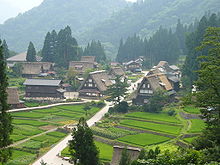Historical villages of Shirakawa-gō and Gokayama
The historic villages of Shirakawa-gō and Gokayama are three villages that were recognized as World Heritage Sites by UNESCO in 1995 . You are in the valley of Shogawa along the boundaries of prefectures Gifu and Toyama in the region Tōkai - Hokuriku on Honshu in Japan .
Shirakawa-gō ( 白 川 郷 , literally: village on the white river ) extends over the village of Shirakawa ( 白 川村 , -mura ) and the western part of the former village of Kiyomi ( 清 見 村 , -mura ) in Ōno district in Gifu prefecture and the former village of Shōkawa ( 荘 川村 , -mura ), both of which were incorporated into Takayama in 2005 .
Gokayama ( 五 箇 山 , literally: five mountains ) extends over the former villages of Kamitaira ( 上 平 村 , -mura ), Taira ( 平 村 , -mura ) and Toga ( 利 賀 村 , -mura ) in Toyama Prefecture , all of them in 2004 in Nanto were incorporated.
The recognized by UNESCO places are Ogimachi ( 荻町 , 36 ° 15 ' N , 136 ° 54' O ), Shirakawa, Suganuma ( 菅沼 , 36 ° 24 ' N , 136 ° 53' O ) in Kamitaira and Ainokura ( 相倉 , 36 ° 26 ′ N , 136 ° 56 ′ E ) in Taira.
Specialty
Shirakawa-gō and Gokayama are known for their houses, which were built in an architectural style called Gasshō-zukuri ( 合掌 造 り , dt .: "Style of hands folded in prayer", see Gasshō ). The Gasshō-zukuri is characterized by the thatched roofs that are up to 60 ° steep and resemble hands folded in prayer. The robust construction in combination with the properties of the straw cover allows the houses to withstand the heavy snowfalls (up to 4 m) in the region and let the snow slide down.
With three to four floors for space-saving accommodation of large families and various crafts, they differ from normal Japanese farmhouses on the one hand in their size and on the other hand in the actively used attic. The region still consists of 96% dense forests, so that agriculture and farms could only be carried out on narrow strips in the river valleys. But since traditional rice cultivation was not very successful, buckwheat and millet were planted. The upper floors of the Gasshō houses were usually used for silkworm breeding , while the rooms below the first floor were used for the production of saltpeter , the raw material for gunpowder. The leaves of the mulberry bushes needed for growing silkworms were also stored in the house to make Japanese paper . While both the saltpetre production came to a standstill with the import of cheaper European saltpetre and the paper production with the introduction of western production methods came to a standstill in the 19th century, silkworm breeding continued into the 1970s.
history
Settled in the 8th century by a Bergasket cult, the center of which was Mount Haku-san , the Tendai-shū gained influence in the 13th century , but this was in turn replaced by the Jōdo-Shinshū . Due to the difficult-to-reach and remote location of the region, society and the lifestyle were shaped almost mainly by the Jōdo-Shinshū, especially by their Kumi system of mutual cooperation among households.
The Shirakawa-gō region was first mentioned in the 12th century, Gokayama in the early 16th century, the village of Ogimachi in the late 15th century, Ainokura in the middle of the 16th century and Suganuma in the early 17th century. From the beginning of the Edo period , Shirakawa-gō was part of the Takayama fiefdom and was directly controlled by the shogunate as Tenryō from 1693 to 1868 . Gokayama remained part of the Kaga (also known as Kanazawa) fief throughout the Edo period .
In the 1950s, the area was fully connected to the outside world.
In the 19th century there were 94 Gasshō houses among the 1,800 houses in the three villages in total. However, with Japan's economic boom between 1950 and 1975, many of the former villagers moved to the cities and houses were demolished to make way for modern ones. As a result, the number of Gasshō houses in the 90s was only 25 and that of all houses even only 148. After a scientific study in the 50s, a national commission for the protection of cultural assets named 5 Gasshō houses as important cultural assets. 1970 Ainokura and Suganuma in Gokayama were declared a national historical site, so that any non-historical changes to the Gasshō houses were prohibited. The residents themselves took care of the preservation of Ogimachi in Shirakawa-gō and founded the Association for the Protection of the Historic Village Landscape in Shirakawa-gō, Ogimachi in 1971.
useful information
Shirakawa served as a template for the fictional location Hinamizawa, which is the plot of the Japanese computer game / interactive novel and television series Higurashi no Naku Koro ni .
See also
swell
- UNESCO World Heritage Center: Advisory Body Evaluation (PDF; 1.3 MB)
Web links
- Official website for Shirakawa-gō including live camera images (Japanese, English)
- Japanese Embassy: Traveling in Japan: Shirakawa-go and Gokayama Historic Villages
- Entry on the UNESCO World Heritage Center website ( English and French ).
- Photo gallery from Ainokura / Gokayama




